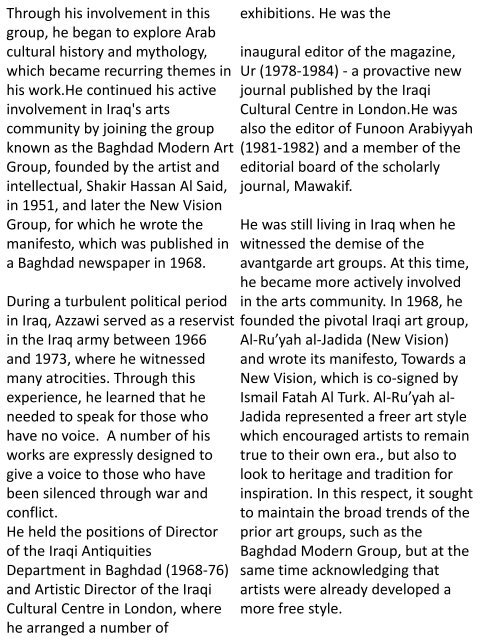Aziz Art October 2018
History of art(west and Iranian)-contemporary art
History of art(west and Iranian)-contemporary art
Create successful ePaper yourself
Turn your PDF publications into a flip-book with our unique Google optimized e-Paper software.
Through his involvement in this<br />
group, he began to explore Arab<br />
cultural history and mythology,<br />
which became recurring themes in<br />
his work.He continued his active<br />
involvement in Iraq's arts<br />
community by joining the group<br />
known as the Baghdad Modern <strong>Art</strong><br />
Group, founded by the artist and<br />
intellectual, Shakir Hassan Al Said,<br />
in 1951, and later the New Vision<br />
Group, for which he wrote the<br />
manifesto, which was published in<br />
a Baghdad newspaper in 1968.<br />
During a turbulent political period<br />
in Iraq, Azzawi served as a reservist<br />
in the Iraq army between 1966<br />
and 1973, where he witnessed<br />
many atrocities. Through this<br />
experience, he learned that he<br />
needed to speak for those who<br />
have no voice. A number of his<br />
works are expressly designed to<br />
give a voice to those who have<br />
been silenced through war and<br />
conflict.<br />
He held the positions of Director<br />
of the Iraqi Antiquities<br />
Department in Baghdad (1968-76)<br />
and <strong>Art</strong>istic Director of the Iraqi<br />
Cultural Centre in London, where<br />
he arranged a number of<br />
exhibitions. He was the<br />
inaugural editor of the magazine,<br />
Ur (1978-1984) - a provactive new<br />
journal published by the Iraqi<br />
Cultural Centre in London.He was<br />
also the editor of Funoon Arabiyyah<br />
(1981-1982) and a member of the<br />
editorial board of the scholarly<br />
journal, Mawakif.<br />
He was still living in Iraq when he<br />
witnessed the demise of the<br />
avantgarde art groups. At this time,<br />
he became more actively involved<br />
in the arts community. In 1968, he<br />
founded the pivotal Iraqi art group,<br />
Al-Ru’yah al-Jadida (New Vision)<br />
and wrote its manifesto, Towards a<br />
New Vision, which is co-signed by<br />
Ismail Fatah Al Turk. Al-Ru’yah al-<br />
Jadida represented a freer art style<br />
which encouraged artists to remain<br />
true to their own era., but also to<br />
look to heritage and tradition for<br />
inspiration. In this respect, it sought<br />
to maintain the broad trends of the<br />
prior art groups, such as the<br />
Baghdad Modern Group, but at the<br />
same time acknowledging that<br />
artists were already developed a<br />
more free style.

















